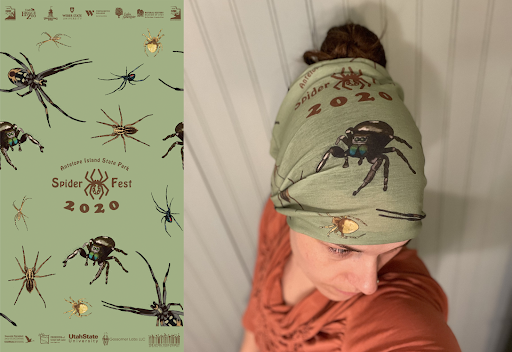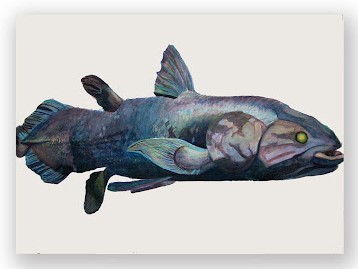The Association of Science Communicators’ volunteers are central to our efforts to serve the scicomm community. For our second volunteer spotlight, we’re featuring Sky Hatter, ASC’s marketing and communications director and webmaster. Scott Hershberger (ASC’s newsletter editor) spoke with Sky about her work as an artist and graphic designer, her experiences in museum exhibit design, and what she enjoys about being involved with ASC.
Scott Hershberger: Why do you think art and graphic design are important for effective science communication?
Sky Hatter: People get really invested in brands. People are drawn to concepts because they’re visually appealing. I think the biggest reason why people are put off by science is because scientists don’t think about how their work looks. That’s part of what’s good about scientists—they’re going to follow the data to the truth—but that’s not necessarily going to communicate the truth in the most effective way. Visually appealing infographics help get people to understand what’s going on, and the principles of art and design can be used to make those graphics more effective and easier to understand.
Scott: What do you do in your day job?
Sky: I have a part-time job working for a nonprofit makerspace. We provide 3D printers, laser cutters, CNC machines for wood cutting, a full sewing room, and more. I recently joined as an administrative coordinator—helping members, a lot of customer service stuff. It’s all for the TEA of the STEAM world: technology, engineering, and art.
I’m also a freelance graphic designer, illustrator, and artist. My favorite thing to do is pet portraits for people because it’s wonderful to capture an animal’s essence for someone. Many times, people cry when they get their pet portrait.
My bread and butter are corporations or nonprofits that need an annual report, or a flyer for an event, or something like that. One of my favorite clients is a group called Great Salt Lake Salty Sirens. They’re these fabulous lady scientists who are trying to save the Great Salt Lake through finding the charismatic megafauna to promote, so I get to do cute brine shrimp logos or make a pelican tattoo. One time I even got to make a spider buff for Spider Fest. That’s fun.

Scott: How did you get interested in science communication?
Sky: I went to the Art Institute of Chicago and took a scientific illustration class at the Field Museum. One day, I was just sitting doing my little painting of a coelacanth from a model that they had, and a herpetologist came by and said, “Hey, would you like to be an intern?”

I got to go into the herpetology lab and work directly from specimens. They asked me to draw a new species of snake for a journal that the Field Museum puts out about their scientists’ work. I used a camera lucida—it’s this attachment to a microscope that creates an optical illusion so that your pen and the specimen are on top of each other in your field of vision so you can trace it. I don’t know if my work was up to snuff to get published, but it was an interesting experience regardless. After that, I was always trying to figure out how to use my artistic skills for scientific purposes.
My science illustration class and internship really gave me the exhibit design bug. I took a part-time temp position as a graphic designer for a temporary exhibit at the Natural History Museum of Utah and got to make large-scale, immersive designs for an exhibit called Natural All Around Us in 2019. Museum exhibit design jobs are few and far between, so it was a while before another opportunity came along in Salt Lake City.
Scott: Outside of museums, you’ve also brought science to nightlife. Can you talk about that?
Sky: A friend and I decided to do a pub science night, so I created the brand for that. I met Justice, my partner, when he saw what we were doing and wanted to join up. Later, Justice and I expanded it into science, technology, engineering, arts, and math, and we added more hands-on projects. Every Christmas we do a gingerbread building competition where you have to build a bridge out of holiday foods. Then you pile on fruitcakes and see how many it can hold. We also did an adult science fair. Sometimes it’s very small, but it’s always fun.
Scott: What do you do as the Director of Marketing and Communications and Webmaster at ASC?
Sky: We have a great marketing and communications team doing the newsletter, blog, and social media, so my role is to make sure they’re all coordinated and strategic. I’m the person that talks to the other board members and turns their goals into actionable deliverables for the marketing and communications team. I’m excited about the growth that we could potentially have, given that we have such a strong team.
The webmaster part isn’t too complicated. I just do the higher-level things like update the homepage. That’s the easiest part of my job.
Scott: Why should people get involved in ASC?
Sky: Science communication is a lonely task when you’re doing it on your own. With our little pub science night, there wasn’t anyone else locally doing anything like that, and we didn’t really have the resources to find the best practices. So Justice and I started going to the Science Talk conferences. The first one we went to was in 2020, which was virtual, and we were set on fire with how effective this community could be. Getting more people who are effective science communicators out in the world, doing good work, is going to lead to better outcomes for everybody.



Leave a Reply